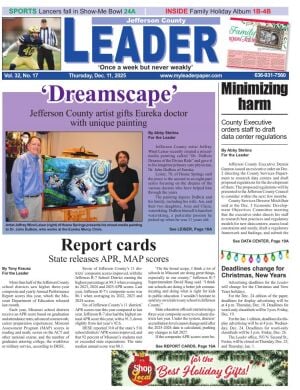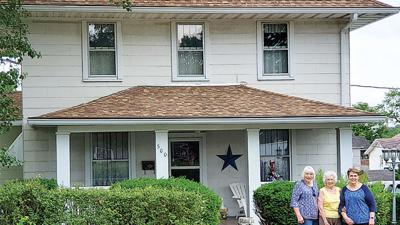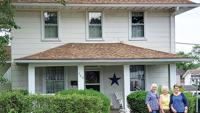Homeowners in record numbers are launching house building, repair and remodeling projects, and feel justifiably proud of their accomplishments. But as intrepid DIY-ers go, these folks can’t hold a candle to a particular set of early 20th century homeowners – the catalog kit home folks. Those are the people who ordered an entire house in kit form from Sears, Montgomery Ward or another catalog company, then assembled it piece-by-piece onsite.
About 100,000 catalog kit homes were ordered and built in the U.S., and historians and researchers say as many as 70 percent have survived as they approach their 100th birthdays.
“They’re just such solid-built houses,” said Debi Govero, who lived in a Sears kit home in Festus for some years. “I’m super impressed by the longevity.”
Starting in 1908, more than 70,000 mail-order Sears Modern Home kits were sold by the retail giant. The basic kit consisted of cut-to-order lumber, each piece stamped with a number, along with roofing, windows, doors, paint, varnish, hundreds of pounds of nails and a 75-page instruction book. Masonry was not included, and bathtubs, sinks, plumbing, wiring and screen doors were add-ons, according to the customer’s requirements.
The kits, with as many as 12,000 individual pieces, were packed onto a railcar and dropped off at the nearest station. Homeowners hauled them to the chosen lot, often by horse-drawn wagon, and got busy building.
The majority of kit homes are located on the East Coast and in the Midwest, with several hundred in the St. Louis area and at least half a dozen in Jefferson County.
They left nothing to chance
Govero, 64, and her husband, Keith, 62, who now live in Ste. Genevieve, bought their Lee Avenue home in Festus in 1982 from the son of its original owner.
“He said the house came by rail and got hauled to the site by horse and wagon. It was a cool old house,” Debi Govero said. “We lived there 13 years. I loved it. It had beautiful hardwood floors, French doors between the living room and dining room, these little windows in the dining room that opened inward.
“When we moved in, the upstairs was unfinished, and we turned it into two bedrooms and a playroom up there. It had no central air.”
They still have the original 1922 blueprints for the house, a Kilbourne model that sold for $2,554.
“The blueprints are super-detailed, pages and pages,” Govero said. “It has everything. Every board was numbered. It even has little drawings of how to arrange the furniture. Keith said they are 10 times more detailed than ones you see today.”
The current owners of that home are Kayla and Michael Christopher, who bought it in early 2020.
“One of the reasons we bought the home was that it is a Sears home,” Kayla said. “We were looking for a house that wasn’t just a typical subdivision house. This one reminded my husband of the home he lived in as a kid, and he loved the feel of it.”
Like any 100-year-old house, theirs has its quirks, but the couple, both 31, have tried to be mindful of its history when updating and renovating.
“It has the original hardwood flooring, almost all the original thick, Craftsman-style trim,” Kayla said. “We replaced a lot of things, but tried to keep the look and feel of it. We didn’t want to modernize the character of the house.”
Linda LaBrier Wall of Festus said in 1928 her grandparents, William and Effie LaBrier, ordered and built a kit home on Eighth Street in Crystal City. She said an aunt still occupies the home.
“My grandma told me the pieces were delivered to the railroad station and brought to their building lot by wagon,” Wall said. “They rented it out the first few years and moved there in 1935. They raised nine kids there – my dad, Albert “Tiny” LaBrier, was the youngest.”
Another sibling, Fran Grillo, 90, purchased the house from her mother in the 1970s and lives there now with her husband, John.
“As long as I can remember, there’s been conversation about whether this might have been a Sears house,” said Grillo’s daughter, Pam Cartee. “The papers my mom has indicates the kit came from a lumber company in Illinois, but it suffered a business-ending fire in the 1920s, and any purchase research our family tried to do couldn’t be confirmed.”
Robert Butler of Cadet posted on Facebook about his grandfather’s Sears house, also in Crystal City.
“My grandfather worked for Crystal Plate Glass Co.,” he said. “They would buy the homes for their employees and deduct the cost from their paycheck without interest, and fellow workers would help build them. He told me the cost of his home on Lindsey Avenue was about $2,500.”
The Weber family, early settlers of western Jefferson County, ordered a catalog house in 1914 and built it on a lot on what is now Hwy. MM in House Springs. The house, now more than 100 years old, was the setting for the May 29 wedding of new owners Christine (Kessler) and Jesse Richardson.
The couple, together for five years, grow a wide variety of plants and keep animals at their home.
“We love it,” Christine said.
Bill Lepp said he also loves his kit home on Old Lemay Ferry Road in Imperial. It was long thought to be a Sears house, but has been determined instead to be a Gilmore style kit home from the Gordon Van Tine company from the same era.
Hiding in plain sight
Other area homes rumored to be Sears catalog houses include one on Main Street in Hematite, one on Cypress Drive in Festus and another on Lee Avenue, near the Goveros’ former home.
It can be difficult to determine whether a house is indeed built from a mail-order kit. Sears alone offered dozens of designs, from the tiny three-room cottage called Goldenrod to the stately, four-bedroom Magnolia. And there were many homes built from the same floor plans but not from kits.
The company did not maintain records of catalog orders, so authentication is something of an exercise in sleuthing. (See related story.)
Company records are helpful. Standard Oil opened the Carlinville Mine in central Illinois early in the 20th century, and in 1917, the company ordered nearly 200 kit homes from Sears, nearly all of which survive. Carlinville is now something of a tourist attraction, with the highest concentration of contiguous Sears homes in the nation, more than 150 in a 12-block neighborhood.
There are several websites dedicated to the identification and preservation of these homes.
Although they have no catalog sales records, Sears does maintain a database of its home plans. Go to searsarchives.com and click on homes to find listings by year, with thumbnail images that expand to full catalog listings.
The Searshouseseeker.com site has detailed information about Sears kit homes in the Midwest, and has catalogued some of the kit homes sold by other companies, like Montgomery Ward, Aladdin, Gordon Van Tine and Sterling.
Rosemary Thornton, who has written several books and given numerous lectures on Sears catalog kit homes, says it’s important to recognize their historical significance.
“They speak to a time in American history that is gone,” she said.




